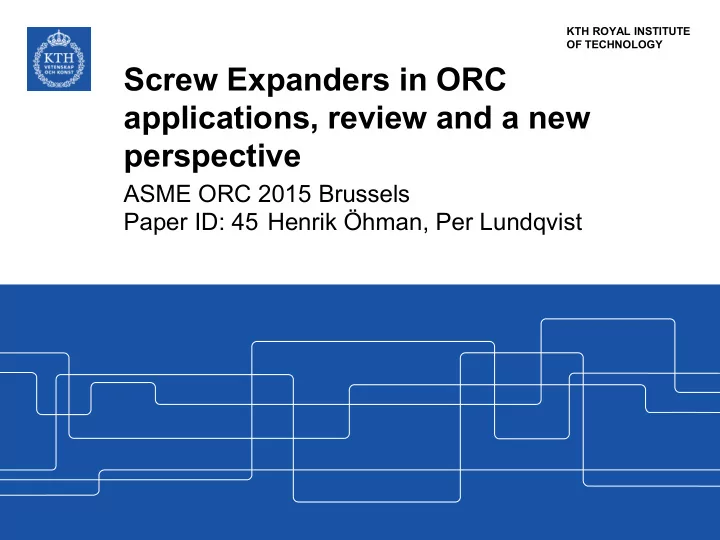

KTH ROYAL INSTITUTE OF TECHNOLOGY Screw Expanders in ORC applications, review and a new perspective ASME ORC 2015 Brussels Paper ID: 45 Henrik Öhman, Per Lundqvist
Content 1. Re-view, leading to new opportunities? 2. 2-phase expansion modeling 3. Implications on ORC systems optimization 4. New perspectives 5. Conclusions
Re-view: Many shapes and forms Main types Many variations Twin Screw Triple Screw Inverted Female Herring Bone
Re-view of Twin Screw Expanders • Dry Entry/Dry Exit • Air-, Steam- and Industrial gas expansion 1930’s • Dry Entry/Mixed Exit • Steam- and humid air expanders 1940’s • 2- and 3-phase expansion • Air+ Oil, Air+Water+Ice (Wagenius,Schibbye) 1950’s • First ORC applications • Automotive(Minto), AirCond(Linde) A NEW 1960’s PERSPECTIVE ON • Liquid Expansion, water OPPORTUNITIES • Geothermal water direct expansion(McKay) 1970’s WITH ORC’s ? • Liquid Expansion, heated refrigerant • Trilateral Flash Cycles(Smith) 1990’s • Liquid Expansion, cooled refrigerant • Expressor, Phase Separator(Brasz,Öhman) 2000’s • Mixed Entry /Mixed Exit + Oil • Efficiency correlation(Öhman,Lundqvist) 2010’s
Re- view: 1960’s ORC applications gain momentum Solar Powered Pumping Automotive propulsion Stations Solar heat + combustion Off-grid water pumping Oil injected Twin Screw Oil injected Twin Screw
2-phase expansion modeling? Dynamic flashing Spontaneous condensation Kanno&Shikazono,2015 , ”Experimental and modeling study on adiabatic two-phase expansion in a cylinder ”, Int.J.of Heat and Mass Transfer.86.755-763
2-phase expansion modeling? Physics Comment Models Application Fluid state Needed at all Quasi-static Non quasi-static conditions positions Spontaneous Instable sub-cooled Non-validated Primary impact condensation gas (vol, expansion) Dynamic flashing Instable super- Non-validated Primary impact heated liquid (vol, expansion) Time constants Damping effects Undefined Differs by order of magnitude Coupled effects Condensation/flashi None available Strongly coupled ng interaction Impact of lubricant Distortion of Equilibrium Strongly time + saturation temp + models system dependent solubility
2-phase expansion modeling: ORC system Physics based Correlation models models Heat exchange Available Available ORC process states Available Available Pump efficiencies Available Available d Adiabatic Expansion Not available ad 0 . 15 0 . 09 2 phase ad , peak dX Efficiency (mixed entry 10 X 1 X ad entry ad , peak 2 phase entry flow) (Öhman, Lundqvist 2013)
Implications on ORC systems optimizations: Variable expansion entry vapor fraction Saturated Super Heated Variable Vapor Saturated Liquid, TFC Gas, ORC Fraction, ORC Gas, ORC NH3 R245fa R134a Öhman, Lundqvist 2014
New perspectives: Importance of fluid choice? Technically Available area Simulated ORC for WHR of Marine diesel jacket cooling water (Öhman, Lundqvist 2014) Envelope of optimized efficiency f(Exp, Entry Vapor Fraction) vs. Utilization. 3 different fluids 3 different lumped efficiency classes FoC Corr is a comparative correlation for real units (Öhman, Lundqvist 2013)
New perspectives: Optimization on vapor fraction? NPO[kWe] HEXs [K/kW/kWe] Max Net Power Out = Max efficiency 700 1500 600 1200 500 900 400 300 600 200 300 h h 100 Max Cost Efficiency entry pump , exit Vh " h h pump , exit 0 0 0.2 0.4 0.6 0.8 1 1.2 Vh Sensitivity to Expansion Entry Vapor Fraction on NPO and Cost Efficiency WHR from Pulp factory (Öhman 2011) (R245fa, Utilization=0.75, Reversible Cycle, Irreversible heat transfer)
Conclusions Physics based “mixed flow” Screw Expander modeling are not yet suitable for application performance predictions. Correlation of “mixed flow” performance allows for ORC systems optimization by process simulation. The perspective of “Variable Mixed Flow Screw Expander Entry” offers: • An alternative to trans-/supercritical, Multi-staging and Zeotropic blends • Opportunities for improved ORC cost efficiency
Thank You! Henrik Öhman, Per Lundqvist henrik@hohman.se
Recommend
More recommend